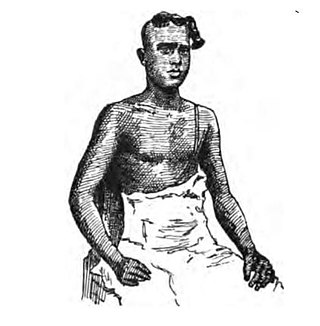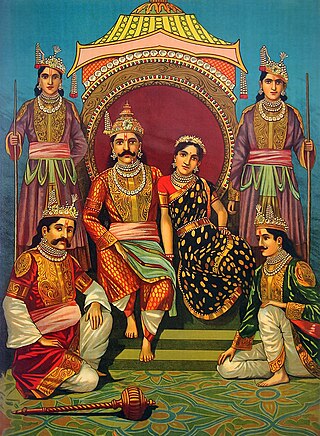Related Research Articles

The Nair, also known as Nayar, are a group of Indian Hindu castes, described by anthropologist Kathleen Gough as "not a unitary group but a named category of castes". The Nair include several castes and many subdivisions, not all of whom historically bore the name 'Nair'. These people lived, and continue to live, in the area which is now the Indian state of Kerala. Their internal caste behaviours and systems are markedly different between the people in the northern and southern sections of the area, although there is not very much reliable information on those inhabiting the north.

The Nair Service Society (NSS) is an organisation created for the social advancement and welfare of the Nair community that is found primarily in the state of Kerala in Southern part of India. It was established under the leadership of Mannathu Padmanaban. The NSS is a three-tier organisation with Karayogams at the base level, Taluk Unions at the intermediate level and a central headquarters operating from Perunna, Changanassery in Kerala. G. Sukumaran Nair is the present General Secretary.
Marumakkathayam was a system of matrilineal inheritance prevalent in regions what now form part of the southern Indian state Kerala. Descent and the inheritance of property was traced through females. It was followed by all Nair castes, Ambalavasi and tribal groups. The elder male was considered the head known as karanavar and the entire assets of the family were controlled by him as if he was the sole owner. The properties were not handed to his sons but to the daughters of his sons or to their sisters.
Nagavanshi refers to any of the several Indian Kshatriya dynasties or ruling groups claiming descent from the mythical Nāgas. Along with Suryavanshi, Chandravanshi and Agnivanshi, the Nagavanshi clans form a part of the Kshatriya class in the Varna system of India. The notable members of this class include:
The caste system in Kerala differed from that found in the rest of India. While the Indian caste system generally divided the four-fold Varna division of the society into Brahmins, Kshatriyas, Vaishyas and Shudras, in Kerala, that system was absent. The Malayali Brahmins formed the priestly class, and they considered all other castes to be either Shudra or Avarna.
Sambandham was an informal mode of marriage followed by Nairs, Samantha Kshatriyas, Kshatriyas, and Ambalavasis among their own communities as well as with the Nambudiris, in what is the present day state of Kerala, India. All of these were matrilineal communities.

The Nambudiri, also transliterated as Nampoothiri, Nambūdiri, Namboodiri, Namboothiri and Nampūtiri, are a Malayali Brahmin caste, native to what is now the state of Kerala, India, where they constituted part of the traditional feudal elite. As the highest ranking caste in South India, they owned a large portion of the land in the region of Malabar until the Kerala Land Reforms starting in 1957, and intermarried with the Nair monarchs and aristocracy through Sambandham. The Nambudiris have traditionally lived in ancestral homes known as Illams and have been described by anthropologist Joan Mencher as, "A wealthy, aristocratic landed caste of the highest ritual and secular rank." Venerated as the carriers of the Sanskrit language and ancient Vedic culture, the Nambudiris held more power and authority than the kings and were "above and outside the political systems of the kingdoms."

Naduvazhi refers to feudal elites, ruling chieftains and descendants of royal kingdoms in various regions that are now administrative parts of Kerala, India. They constituted the aristocratic class within the Hindu caste system and were either kings themselves or nobility in the service of the kings of Kerala.
Panicker was a title conferred by the king of Travancore to distinguished individuals.

Indulekha is a Malayalam novel written by O. Chandu Menon. Published in 1889, it was the first major novel in the Malayalam language. It was a landmark in the history of Malayalam literature and initiated the novel as a new flourishing genre. The novel is about a beautiful, well-educated lady of a Nair tharavad.

The Ezhavas are a community with origins in the region of India presently known as Kerala, where in the 2010s they constituted about 23% of the population and were reported to be the largest Hindu community. They are also known as Ilhava, Irava, Izhava and Erava in the south of the region; as Chovas, Chokons and Chogons in Central Travancore; and as Thiyyar, Tiyyas and Theeyas in the Malabar region. Some are also known as Thandan, which has caused administrative difficulties due to the presence of a distinct caste of Thandan in the same region. The Malabar Ezhava group have claimed a higher ranking in the Hindu caste system than do the others, although from the perspective of the colonial and subsequent administrations they were treated as being of similar rank.
Kettu Kalyanam, also known as Thali Kettu, was the name of an elaborate marriage ceremony of the Samanthan, Nair, Maarar, and Ambalavasi communities of the southern Indian state of Kerala. The customs varied from region to region and caste to caste. Sambandham might take place only if the bride had already had this elaborate ritual mock-marriage known as Kettu Kalyanam. The Kettu Kalyanam is ceremonial only, for after the rituals the groom returns to his house, never to meet the bride again. In some parts of Malabar immediately after the ceremony, a formal divorce is constituted, whereas in other areas the groom enters into sambandham with the girl and becomes her husband in practice, if the girl be of marriageable age.This practice was not performed in North Malabar.
Events in the year 1896 in India.

Polyandry in India refers to the practice of polyandry, whereby a woman has two or more husbands at the same time, either historically on the Indian subcontinent or currently in the country of India. An early example can be found in the Hindu epic Mahabharata, in which Draupadi, daughter of the king of Panchala, is married to five brothers.
There are numerous ceremonies and customs adopted by the Nair caste, which is prominent in the South Indian state of Kerala.

Kiryathil Nair or Kiriyath Nair is a martial nobility caste belonging to the Kshatriya varṇa, which forms one of the highest-ranking subcastes of the Nair community along with the Samantha Kshatriyas with whom they share a close history. They constituted the ruling elites (Naduvazhi) and feudal aristocrats (Jenmimar) in the regions of Malabar and Cochin in present-day Kerala, India, and have traditionally lived in ancestral homes known as Tharavads. As the pinnacle of the Nair hierarchy, the Samanthan and Kiryathil Nairs were second only to the Namboodiri Brahmins in the social status system of Kerala, and outranked even the priestly Ambalavasis.
Chakkala Nair, also known as Vattakkat Nair, and Vaniya Nair is one of the intermediate subcastes of the Nair community. They are distributed throughout Kerala. In Travancore, they are known as Chakkala, while in Cochin and Malabar they are Vattakattu and In the extreme north of Malabar they are called Vaniya

The Koli is an Indian caste found in Rajasthan, Himachal Pradesh, Gujarat, Maharashtra, Uttar Pradesh, Haryana, Karnataka, Odisha and Jammu and Kashmir states in India. Koli is an agriculturist caste of Gujarat but in coastal areas they also work as fishermen along with agriculture. In the beginning of 20th century, the Koli caste was recognised as a Criminal Tribe under Criminal Tribes Act by British Indian government because of their anti-social activities during World War I.
Christopher John Fuller is an emeritus professor of anthropology at the London School of Economics and a Fellow of the British Academy. He has studied and written extensively about the people of India, particularly with regard to subjects such as Hinduism, the caste system, and the relationship between globalisation and the middle-classes.
Hiranyagarbha is an ancient Indian ritual ceremony involving the donation of a golden vessel. Throughout history, it was used as a purification ritual meant to "enhance" or "upgrade" the performer's social status and standing. One of the most noted examples of this was the change in the caste status of a high-ranking Nair monarch, such as the Zamorin, to that of a Kshatriya when he completed the ceremony. It is also mentioned as one of the "Sixteen great gifts" in the historical texts.
References
- 1 2 Panikkar, K. M. (July–December 1918). "Some Aspects of Nayar Life". Journal of the Royal Anthropological Institute. 48: 271. Retrieved 24 June 2011.
- 1 2 Kodoth, Praveena (May 2001). "Courting Legitimacy or Delegitimizing Custom? Sexuality, Sambandham and Marriage Reform in Late Nineteenth-Century Malabar". Modern Asian Studies. 35 (2): 350. doi:10.1017/s0026749x01002037. JSTOR 313121. PMID 18481401. S2CID 7910533.(subscription required)
- ↑ Fuller, C. J. (Winter 1975). "The Internal Structure of the Nayar Caste". Journal of Anthropological Research. 31 (4): 283–312. doi:10.1086/jar.31.4.3629883. JSTOR 3629883. S2CID 163592798.(subscription required)
- ↑ Nossiter, Thomas Johnson (1982). "Kerala's identity: unity and diversity". Communism in Kerala: a study in political adaptation. University of California Press. p. 27. ISBN 978-0-520-04667-2 . Retrieved 24 June 2011.
- ↑ Fuller, C. J. (Winter 1975). "The Internal Structure of the Nayar Caste". Journal of Anthropological Research. 31 (4): 296. doi:10.1086/jar.31.4.3629883. JSTOR 3629883. S2CID 163592798.(subscription required)
- ↑ Kodoth, Praveena (May 2001). "Courting Legitimacy or Delegitimizing Custom? Sexuality, Sambandham and Marriage Reform in Late Nineteenth-Century Malabar". Modern Asian Studies. 35 (2): 351. doi:10.1017/s0026749x01002037. JSTOR 313121. PMID 18481401. S2CID 7910533.(subscription required)